 Run Amok Combat Robotics
Run Amok Combat Robotics
Your kiwi drive mix is probably wrong!
Privacy Policy
EdgeTX Kiwi Drive Mix
Q: I'm building a three-wheel kiwi drive beetle and I'm looking for a mix for my Radiomaster transmitter. Your EdgeTX combat guide has a mix for a four-wheel Mecanum omnidrive but not for a kiwi drive. Is the mix for my three-wheel kiwi drive omnibot similar to the Mecanum mix?
A: The FIRST robotics competitors are fond of the kiwi drive and have written a good bit about them. Lots of vector analysis and trigonometry. You can find one such discussion of kiwi drive control at stackoverflow.com: How to Control a Kiwi Drive Robot. Translating the information from that discussion to an EdgeTX mix gives us this:

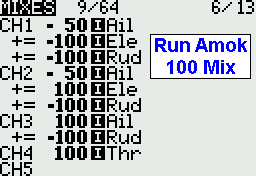
The drive ESCs plug into the receiver ports as labeled; receiver port CH4 is available for weapon control. With a standard mode 2 stick layout:
Left stick: ↔ rotation and ↕ weapon.
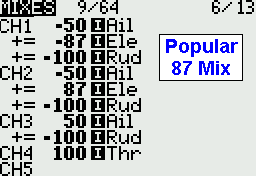
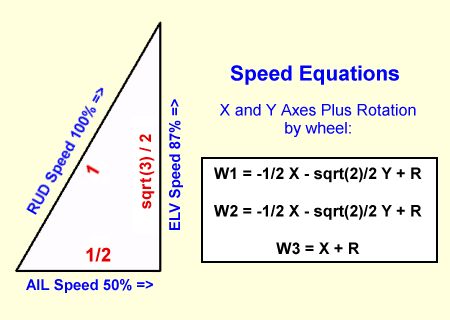 Reply: The motor control inputs that you (and pretty much everybody else) are using are based on a set of equations developed to calculate the maximum Y and X axis speeds for each of the three wheels as a trig function of the available straight-ahead wheel speed -- see image inset. Transferring these speed function coefficients into Aileron and Elevator mix weights is flawed logic that results in a 'bot that is both unnecessarily slow and unable to maintain correct linear response to transmitter inputs.
Reply: The motor control inputs that you (and pretty much everybody else) are using are based on a set of equations developed to calculate the maximum Y and X axis speeds for each of the three wheels as a trig function of the available straight-ahead wheel speed -- see image inset. Transferring these speed function coefficients into Aileron and Elevator mix weights is flawed logic that results in a 'bot that is both unnecessarily slow and unable to maintain correct linear response to transmitter inputs.
The images below graphically show the percentage of available power applied to each of the three motors throughout the full range of non-rotational holonomic motion. An efficient mix will have less 'grey' underpowered area in their graph, and the grey areas will be triangular.

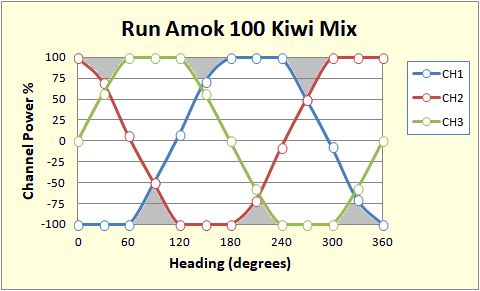
Experimentally minded builders may wish to play with the Desmos Kiwi Drive Calculator.
BONUS: Someone will eventually point out that my Kiwi mixes for CH1 and CH2 are "non-linear" and that for perfect Kiwi control they should be "linear". Yes, although my Kiwi 100 mix is efficient it imperfectly fits the "ideal" Kiwi control profile -- off by as much as 9% in places.
I doubt you'd ever notice this disparity in the real world, but to head-off complaints from perfectionists I assembled a version of the mix that incorporates a set of six custom curves to warp all three Kiwi control channels into their correct shapes.
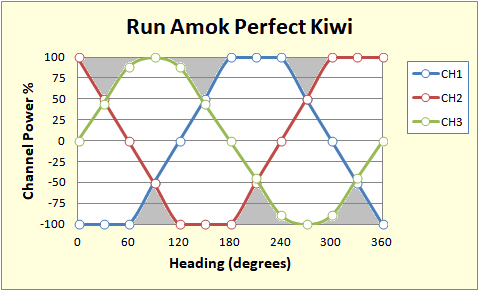
I personally wouldn't bother.
Q: Will you please walk me through how the mix works? I'd like to know how to modify it for a non standard design. What changes if the wheels aren't set 120° apart? What changes if the wheels aren't equidistant?
A: Sure. Using the convention from the stackoverflow.com discussion, where a '+' value spins the motor clockwise and a '-' value spins the motor counter-clockwise:
- CH1 motor spins counter-clockwise;
- CH2 motor spins clockwise;
- CH3 motor does not spin;
- CH1 motor spins counter-clockwise at 50% the speed of CH3;
- CH2 motor spins counter-clockwise at 50% the speed of CH3;
- CH3 motor spins clockwise at full speed;
- Spins the CH1 motor counter-clockwise;
- Spins the CH2 motor counter-clockwise;
- Spins the CH3 motor counter-clockwise;
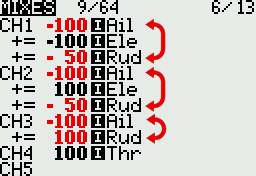 Q: I'd rather put the sideways strafe control on the left stick and move rotation to the right stick. Is that an easy change?
Q: I'd rather put the sideways strafe control on the left stick and move rotation to the right stick. Is that an easy change?
A: Just swap the AIL and RUD weights for CH1, CH2, and CH3 in the MIXES screen to flip strafe and rotation sticks. The values after swaping are shown in red in the screenshot on right.
EdgeTX Mecanum Drive Mix
Q: You mentioned that it's possible to program a Mecanum wheel omni-drive mix in EdgeTX firmware. What would that look like?
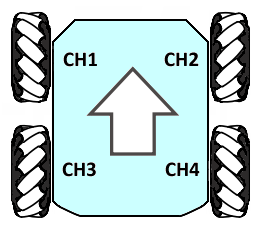
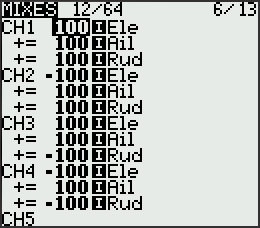
Assuming that you want a standard single-stick drive on the right stick with the added side-strafe control on the left 'rudder' axis, your channel layout and MIXES page are shown in the pictures above.
Real omni-drive jockeys may prefer putting strafe on the right stick and rotation on the left. Just swap the 'Ail'eron and 'Rud'der weights on CH3 and CH4 in the MIXES screen to give that a try.
Reply: Under some control combinations my Mecanum mix does reach maximum throttle before reaching full stick travel -- but so does the standard delta wing (elevon) mix so widely used in robot combat.
A Mecanum drive robot in an industrial application might require uniform and linearly precise speed control on all axes, but a Mecanum combat robot demands full power and speed along any given control axis. I encourage you to implement my control mix on a combat Mecanum drive 'bot to see if the loss of sensitivity actually causes any issues for you before pursuing exotic solutions.
